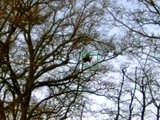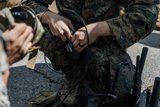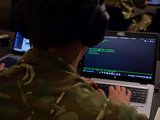Lockheed Martin supports real-time ISR for Red Flag
The Distributed Common Ground Station Imagery (DCGS-I) mobile test bed modernised by Lockheed Martin in 2012 has been used to provide advanced exploitation of intelligence, surveillance and reconnaissance (ISR) capabilities during the US Air Force aerial warfare Red Flag exercise.
The DCGS-I is used by the US Department of Defence to test ISR capabilities prior to their introduction into an operational environment. During Red Flag, live imagery from manned and unmanned aircraft was disseminated in near real-time to the DCGS-I at a ‘level never before achieved’, the company said.
Lt. Col. Christopher Reiz, the 526th Intelligence Squadron commander, said: ‘Red Flag was a huge success, and a large chunk was due to the DCGS-I capabilities. DCGS-I was a critical part of our High Altitude mission and pivotal to the successful execution of reconnaissance missions and in providing realistic combat training.’
Red Flag exercises are realistic aerial war games intended to prepare pilots from the US, NATO and other allied countries for combat situations. According to Lockheed Martin, this is the first time that the US Air Force brought together not just the platform and supporting sensors, but also the analysis of the collected intelligence data, as well as the communications paths upon which the data travels.
Jim Quinn, vice president of C4ISR systems for Lockheed Martin Information Systems & Global Solutions, said: ‘This is a major step forward in exploring the true potential of real-time intelligence. The value that analysing and sharing ISR data offers for success in future conflicts is clear: a holistic understanding of a complex battlespace.’
During Red Flag, raw intelligence from manned and unmanned ISR assets was sent to DCGS-I, which served as the primary data link, processor, and delivery mechanism for the Synthetic Aperture Radar (SAR) imagery taken from the U-2, as well as the backup data link for the SAR and infrared imagery taken by the Global Hawk. Analysts reviewed the data, and in collaboration with the Air Operations Center, sent the intelligence products to users, allowing for a more effective prioritisation of combat assets.
Users from dissimilar classification environments were able to review imagery gleaned from the airborne platforms through the use of Lockheed Martin's cross domain solution Trusted Manager (TMAN). TMAN automatically disseminated imagery from the secret DCGS-I environment to the top secret Air Force common workstations, allowing airmen to work seamlessly at both the secret and top secret security levels.
More from Digital Battlespace
-
![Chess Dynamics successfully demonstrates Vision4ce AI-driven tracker]()
Chess Dynamics successfully demonstrates Vision4ce AI-driven tracker
The Vision4ce Deep Embedded Feature Tracking (DEFT) technology software is designed to process video and images by blending traditional computer vision with artificial intelligence (AI) algorithms to present actionable information from complex environments.
-
![Wave Relay devices cleared for security use on commercial systems in industry trend]()
Wave Relay devices cleared for security use on commercial systems in industry trend
Persistent Systems has been cleared by National Security Agency (NSA) to transmit sensitive data on commercial networks. The devices are added to the NSA’s Commercial Solutions for Classified (CSfC) component list which also includes other companies’ products providing the same security.
-
![UK teases cyber spending boost in Strategic Defence Review ahead of “imminent” release]()
UK teases cyber spending boost in Strategic Defence Review ahead of “imminent” release
The release of the UK’s Strategic Defence Review (SDR) has been long promised as mid-year. It is possible it could be as early as 2 June although the UK Ministry of Defence (MoD) continues to play its cards close to its chest.
-
![Intelsat emphasises SATCOM resilience for SOF in contested domains (video)]()
Intelsat emphasises SATCOM resilience for SOF in contested domains (video)
Intelsat outlines how its multi-orbit SATCOM architecture is enhancing connectivity and resilience for special operations forces operating in degraded and contested environments.
-
![US Space Force’s next-generation missile warning system moves forward with $500 million in new contracts]()
US Space Force’s next-generation missile warning system moves forward with $500 million in new contracts
Next-Generation Overhead Persistent Infrared (Next-Gen OPIR) satellites are intended to provide early warning of missile launches from any location worldwide and new ground stations will result in expanded coverage of critical missile warning.























